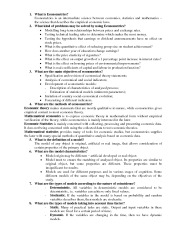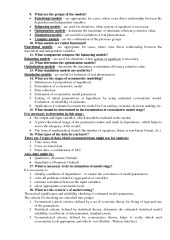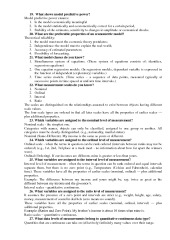Econometrics Exam Questions



Econometrics exam questions.
What are the types of models according to the nature of coincidence?
Dynamic. If the variables are changing in the time, then we have dynamic models.
Balancing models – are used for situations, when system of equations is necessary.
Optimization models – determine the maximum or minimum efficiency criterion value.
Simulation models – are useful for imitation of real phenomenon.
Complex models – are the combination of the previous groups.
Functional models – are appropriate for cases, where exist direct relationship between the dependent and independent variables.
If Festimated > Fk,n-k-1 , then with a 95% confidence level, the null hypothesis is rejected, that the regression is statistically insignificant, and accept an alternative that at least one independent variable has a statistically significant effect on the dependent variable. And in the opposite, if Festimated < Fk,n-k-1 is true, then we can not reject the null hypothesis.
variables and adds one variables at a time as long as a significant variables exists?
Which variable selection procedure in regression analysis permits a variable elimination or adding in every step?
Usually time series are represented by the Yt, where t = 1, 2, ..., n is conditional time.
Cyclical component forms long-term cycles of demographic, economic or astrophysical nature (solar activity cycles, demographics, and so on.). The analytical expression of cycle function usually involves trigonometric functions.
Additional components are included in the model, by using specific variables – dummy variables, or regression variables (more generally).
Parametric methods give us analytical time series expression and estimates of each component. Nonparametric methods give us only estimates of each components.
1) The mean of time series does not depend on time: E(Yt ) =(y =const1 ; (Mean in each set of time series observations must be the same)
2) The autocovariance of time series does not depend on time: E[(Yt -(y )(Yt-k -(y )]=(k (Autocovariance in each set of time series observations must be the same)
Non-stationary time series can be transformed into the stationary by using differential transformation (integration procedure):
– If first-order integrated series are also not stationary, then second order transformation can be applied, etc.
The process of integration and its order are usually marked as I(d), where d is the order of integration. When differential transformation of order d is stationary, we will mark ΔdXt~I(0): –
We say that Xt is integrated of order 1, I(1), if it has to be differenced once to get a stationary time series;
Zero mean, homoscedastic and uncorrelated process is called as white noise process, tag. Xt ~ WN
Both white noise and stationary time series have constant variance, are independent and homoscedastic. White noise process will always be a stationary process, but stationary process will not always be a white noise process.
Autoregressive process, tag. AR(p) explains the time series observations in accordance with the previous observations of time series.
- Economy & Finance Notes
- Microsoft Word 1189 KB
- 2017 m.
- English
- 15 pages (6159 words)
- University
- Laima

















